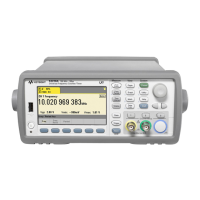53220A/53230A Measurements 3
Keysight 53220A/53230A User’s Guide 87
SCPI Syntax Conventions
Programming the counters through their LAN, USB, and GPIB interface is
achieved using the Standard Commands for Programmable Instruments (SCPI)
control language. A typical example of the SCPI language syntax is shown for the
following MEASure command:
MEASure:FREQuency? [{<expected>|MINimum|MAXimum|DEFault}
[,{<resolution>|MINimum|MAXimum|DEFault}]][,<channel>]]
The programming conventions are as follows.
Command keywords and abbreviated commands
Command keywords (e.g. MEASure, FREQuency?) are separated by a colon (:).
Upper case letters indicate the abbreviated spelling of the keyword or parameter.
Either the abbreviated form or the entire command/parameter must be used.
Optional keywords and parameters
Optional (implied) keywords and parameters are indicated by square brackets
(e.g. [,<channel>]) and are not included when the command is sent. If an
optional parameter is not specified, a default value is used.
Separating commands and parameters and linking SCPI commands
A space must separate the last keyword and the first parameter. Commas (,)
separate multiple parameters. The ‘@’ symbol must precede each counter channel
number and parentheses must enclose each channel:
MEAS:FREQ:RAT? 5E6,(@2),(@1)
Multiple subsystems To send multiple SCPI commands in a single string,
commands within different subsystems (root nodes) must be separated by a
semicolon (;) and a colon (:). For example, the string:
INP:COUP AC;:TRIG:SOUR EXT
requires a semicolon and a colon because the subsystems/root nodes (INPut and
TRIGger) are not the same.

